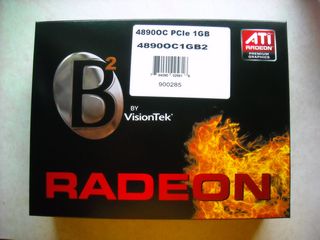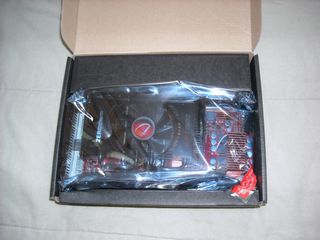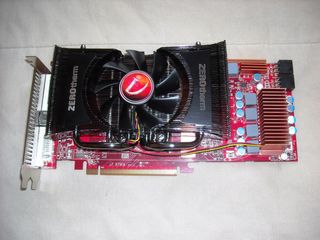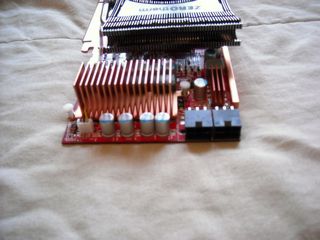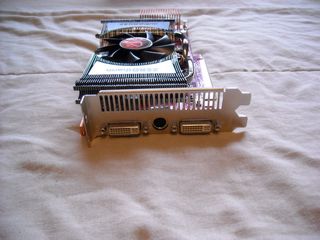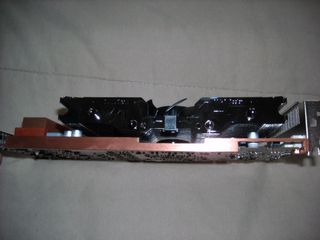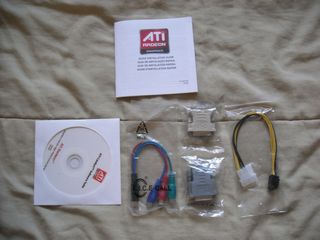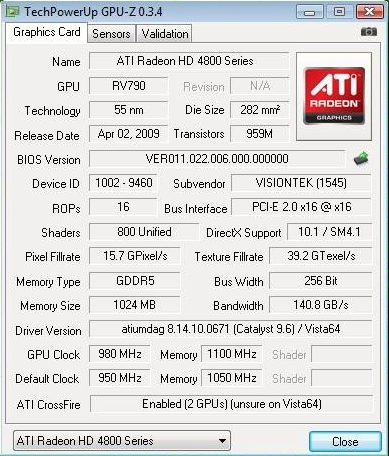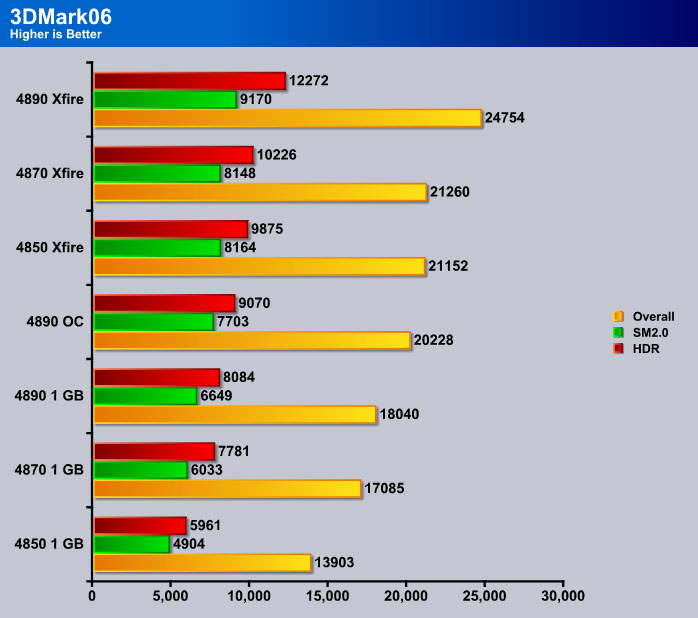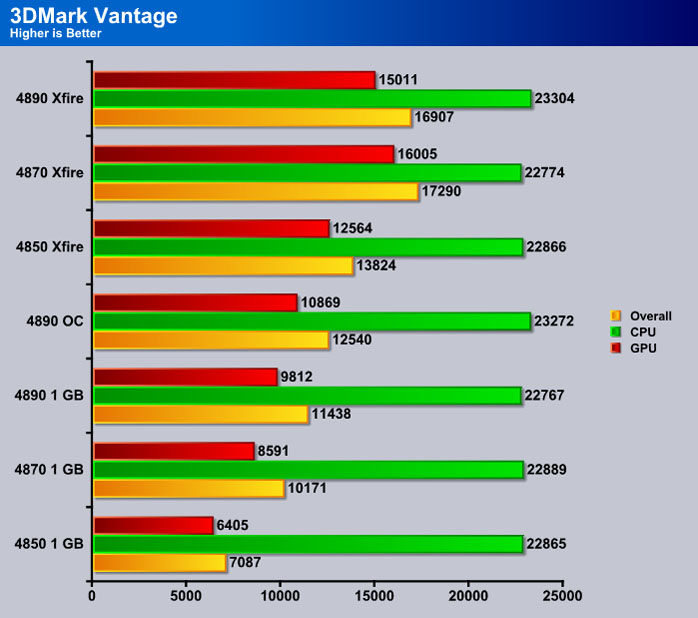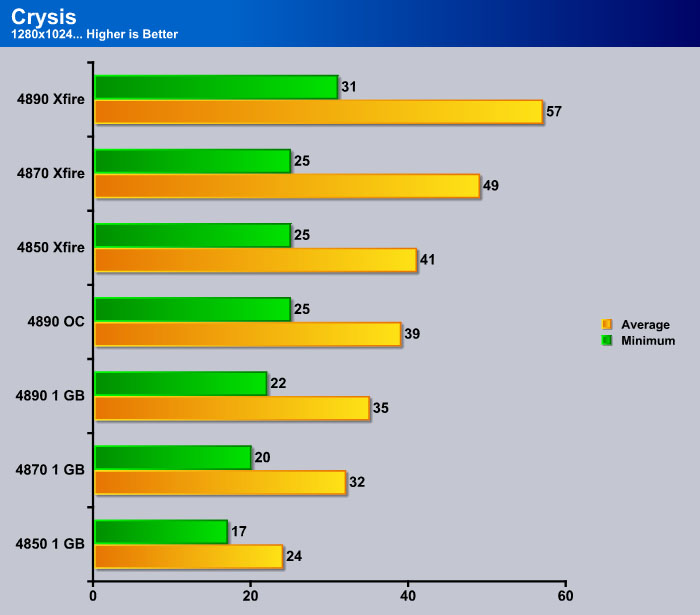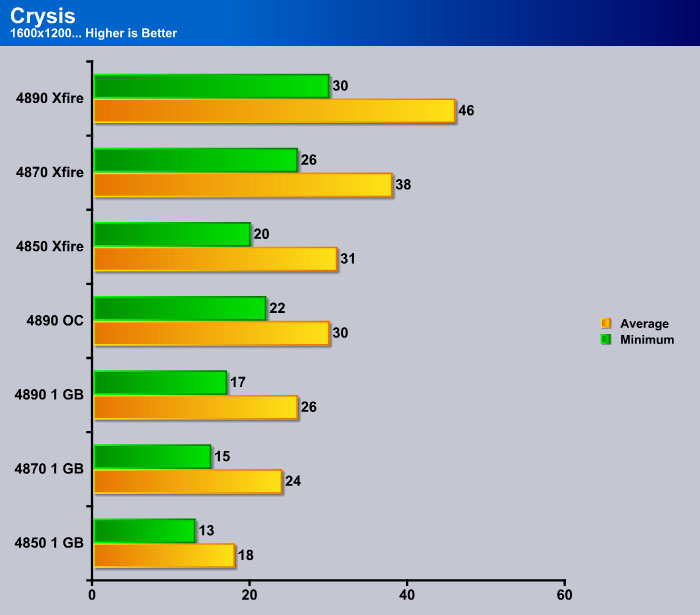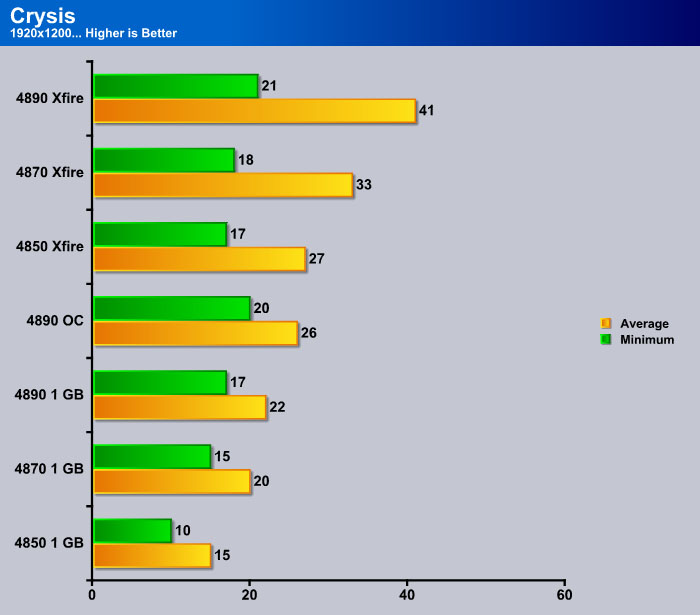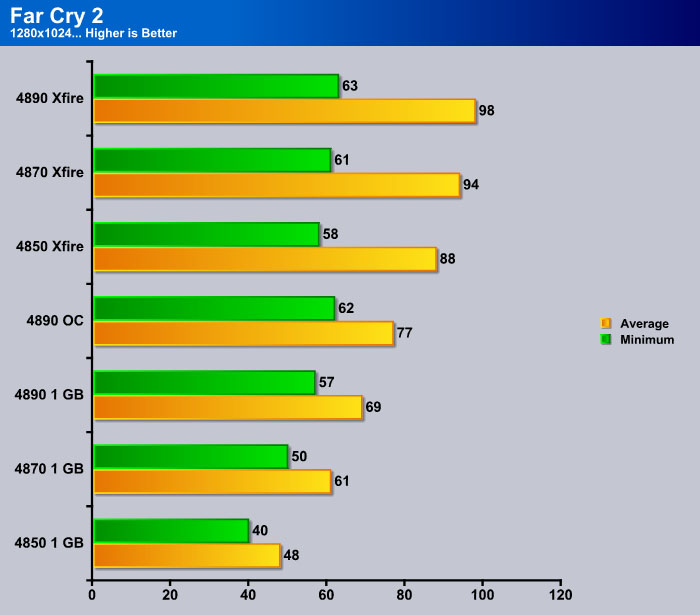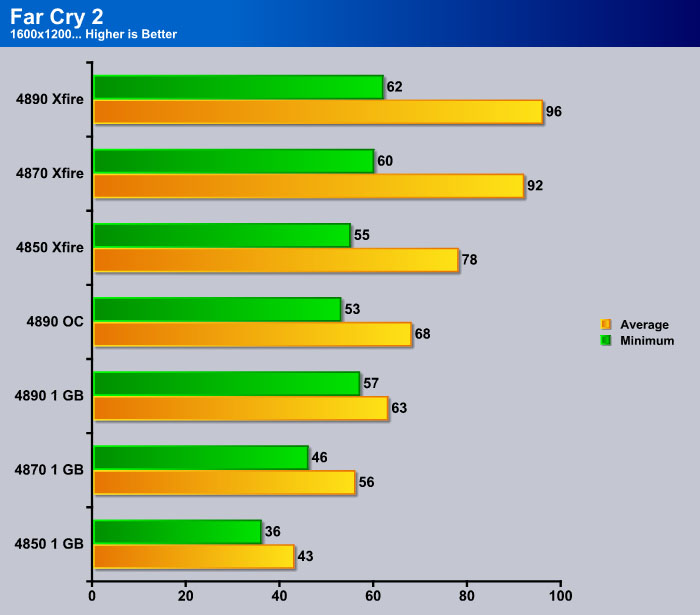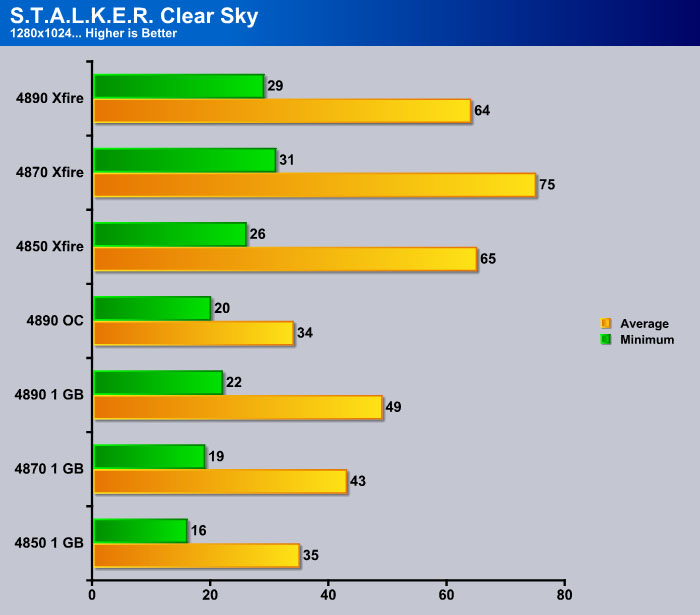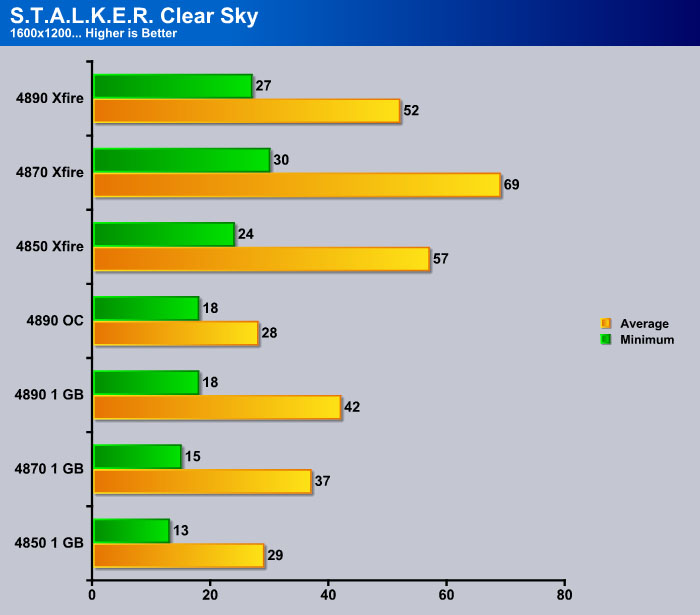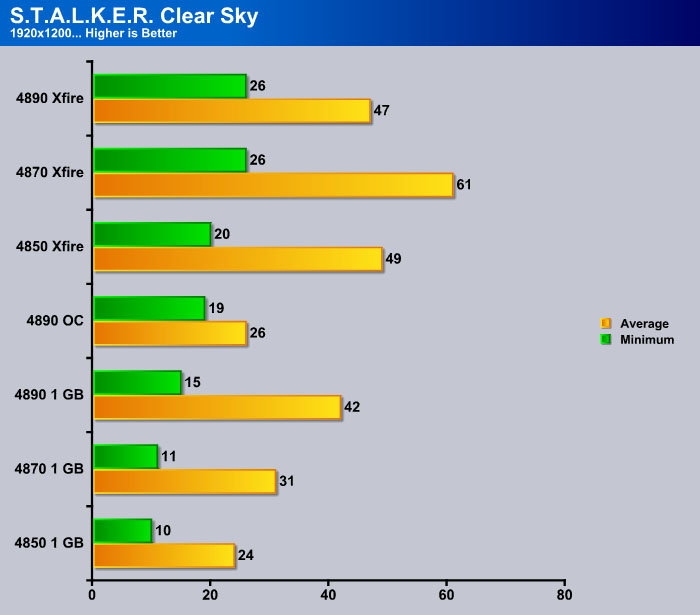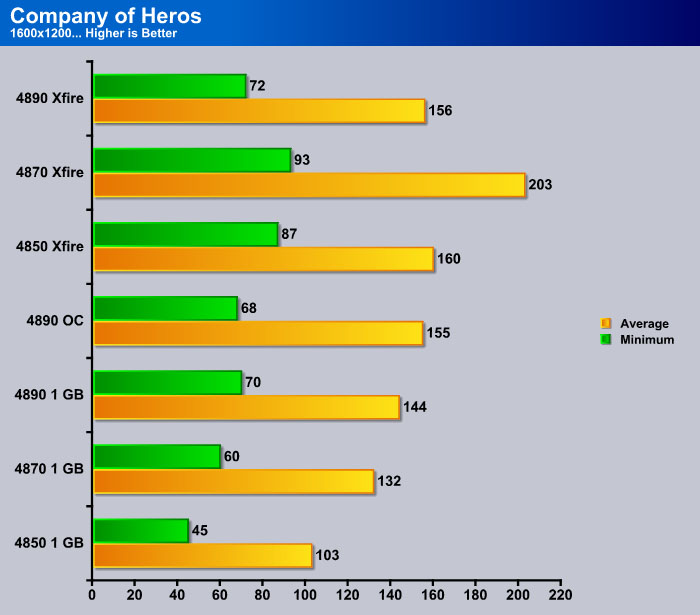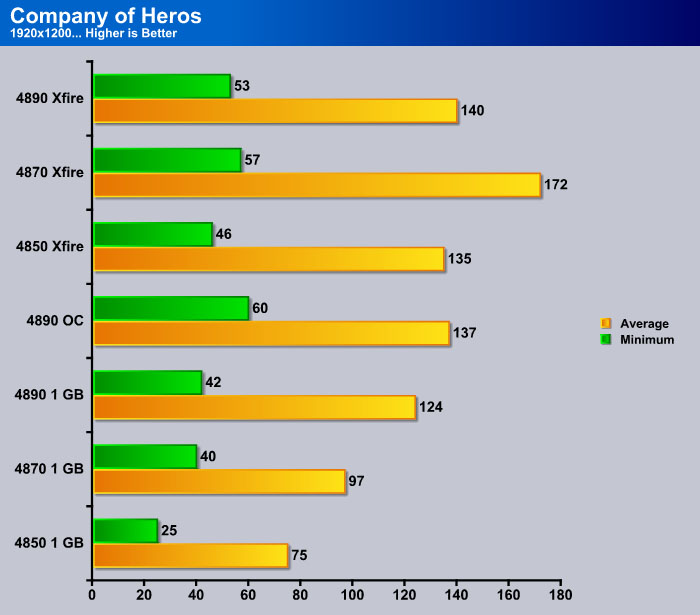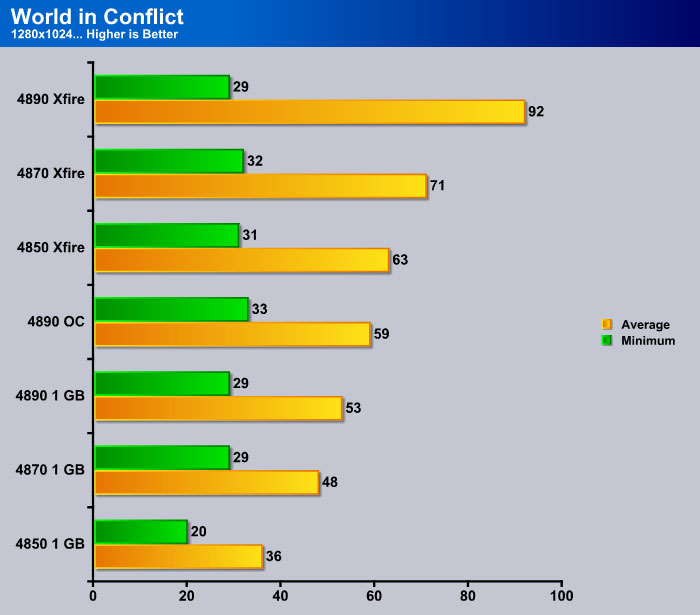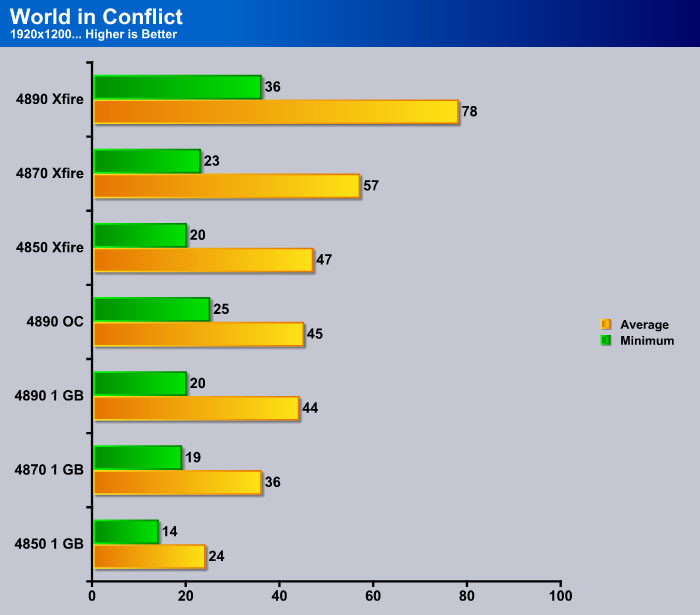When one 4890 just isn’t enough then there are not a whole lot of options for expansion. Your best bet is to grab another 4890, and run Crossfire. Today we have the VisionTek 4890 here to do just that.
introduction
In the world of PC gaming you can never really have enough GPU power. This is why many enthusiasts choose to run multi GPU systems. When you decide to go with either SLI or Crossfire many problems can arise. The first being compatibility. Crossfire boards are far more common than SLI boards, but Intels new X58 chipset is quickly changing the tide.Today we are going to test one of the most extreme Crossfire system, two 4890’s.
Despite the rumors going around, VisionTek has not filed for bankrupcy. In fact they are doing pretty good, and have decided to send us their new 4890 OC edition to review in Crossfire. VisionTek did not only overclock the card, they also included a aftermarket heat sink to go with it. There are many other OC edition cards out there, but none quite like this one. With a core speed of 950 MHz, this card really means busness. Today we will put this card to the ultimate test, not only comparing it to another stock clocked 4890, but also pairing it with the other 4890 to produce one of the ultimate Crossfire configurations.
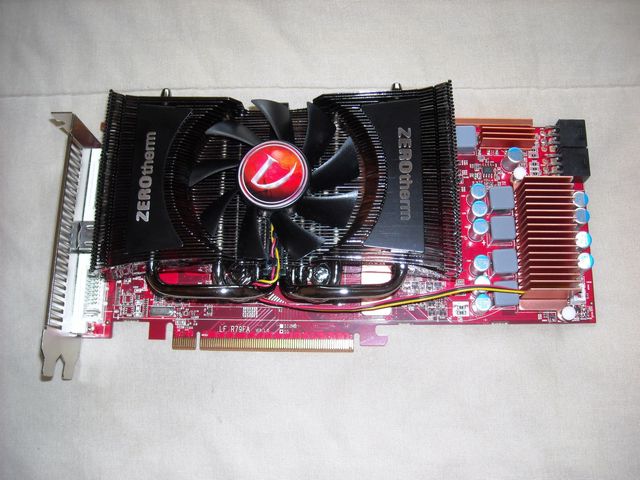
Now that youv’e got a short glimpse of the card lets look at whats under the cooler.
features
- 1 GB GDDR5 memory
- DirectX® 10.1 support
- 800 stream processing units
- 24x custom filter anti-aliasing (CFAA) and high performance anisotropic filtering
- Quad mode ATI CrossFireX™ multi-GPU support for highly scalable performance1
- PCI Express® 2.0 support
- Dynamic geometry acceleration
- Game physics processing capability
- ATI Avivo™ HD video and display technology2
- Unified Video Decoder 2 (UVD 2) for Blu-ray™ and HD Video
- Accelerated Video Transcoding (AVT)
- DVD Upscaling
- Dynamic Contrast
- Built-in HDMI with 7.1 surround sound support
- Integrated DisplayPort**
- Dynamic power management with ATI PowerPlay™ technology2
- ATI Stream technology2
THe specs are what you would expect from a 4890, afterall its just a overclocked card not its own unique GPU.
specifications
| VisionTek 4890 OC | Sapphire 4890 | |
|---|---|---|
| Stream Processors |
800 |
800 |
| Core Clock |
950 |
850 |
| Memory Clock |
1050 |
975 |
| Memory |
GDDR5 |
GDDR5 |
| Cooler Size |
Dual Slot |
Dual Slot |
| ROPs |
16 |
16 |
| Memory Bus (bits) |
265 | 256 |
| Memory Size |
1 GB | 1 GB |
| Texture Units |
40 | 40 |
As you can see the cards are identical minus one thing, clocks. The VisionTek 4890 OC has a much higher core and memory clock which should lead to higher benchmark scores over the stock clocked Sapphire 4890.
pictures & impressions
As you can see, the box is pretty standard. I like the flames in the bottom right corner, but one thing noticeably absent is all of the features of the card. Normally boxes of graphics cards (particularly overclocked ones) have the whole front taken up by these “advertisements”. This may not be the final production box, so VisionTek may change the look of the box later on before the release of the card.
When the box is opened, you can see that VisionTek did a decent job on packaging. They could have added some padding to help keep the card safe in-case of it being dropped, but the cardboard sides should be enough to keep the card safe as long as there is not a lot of rough handling. You can also see that VisionTek wrapped the card in a anti-static bag which will keep the card safe from receiving a static discharge that will render the card useless.
Now that the anti-static bag is off we can really get a look at the card. As stated earlier, this is not the stock ATI heatsink. Instead it is made by Zerotherm. A quick look at Zerotherm’s website revealed that this cooler is not currently available to buy. Perhaps after this card is released Zerotherm will release this cooler. If you look to the right you can see the VRM heat sink. The heatsink is quite large, and should keep the VRM’s cool.
If we take a closer look at the back we see that this card has the same dual 6 pin PCIE power connectors as the regular 4890. I am a bit surprised that VisionTek did not pull a page from Sapphire’s book and put a 6 pin and a 8 pin PCIE power connector. The added power from the 8 pin might have helped this card overclock even more.
When we take a look at the front of the card we can see a pretty standard layout for the 4890. VisionTek ditched the VGA connector and instead went with two DVI connectors. This is a good move, as most users with this card will have a DVI capable monitor. In the middle is the S-video like plug in. You have the option of using either normal RCA, or Component video through this connection. Component can be used for HD TV’s, while regular RCA can be used for any TV with the yellow RCA plug in.
Lets take a look at the side of the card now. It is a bit hard to read with this small of a image, but it does say Zerotherm on the side of the heat sink. Zerotherm did a good job with the heat pipes on the heatsink. They extend just past the heatsink fins, so the fins can have the most area possible to absorb the heat from the heat pipes. VisionTek also added a nice stylish copper band around the side of the card. This gives the card a bit of originality, but don’t touch it because it gets a bit hot when the card is at full load.
Its finaly time for the part you probably like least, the accessories picture. VisionTek includes all of the necesities, but make sure your power supply has at least one 6 pin PCIE power connector, or you wont be able to run this card. Ideally you should have two, and most newer power supplies have two. There are also DVI to VGA and DVI to HDMI adapters included. All ATI card output sound through the card, so no further installation is needed to run your audio to the card like on Nvidia cards. VisionTek also put a driver CD and quick install manual, but I recommend downloading the latest drivers straight from ATI ‘s site. The blue, red, and green cables are component cables. Now on to the benchmarks.
Metholdology
To test this card, we did a fresh load of Vista 64 bit and applied all the patches and updates for the OS, then we updated all the motherboard drivers and made sure that we had the latest 9.5 Catalyst and 182.50 Forceware drivers. We didn’t install any video drivers on the test rig at first, we just installed the basics and then cloned the hard drive using Acronis. That way when we switch from the ATI GPU to the Nvidia GPU we can have a fresh load with no old drivers hanging around to bugger up our benchmark numbers.
We ran each test 3 times and averaged the results, the average of those results are reported here. The one exception to the 3 run rule is Stalker, this test is just so long so it was run twice. Below is a detailed list of the components used during testing.
| Test Rig | |
| Case Type | Ikonik Ra X10 Liquid |
| CPU | Intel i7 920 @ 3.7 Ghz |
| Motherboard | MSI X58M |
| Ram | (6x2GB) DDR3 @ 1482 8-8-8-20 |
| CPU Cooler | D-Tek Fuzion |
| Hard Drives | Corsair P64 Western Digital 750 GB |
| Optical | LiteOn DVDR |
| GPU’s Tested |
HIS HD 4850 1 GB |
| Testing PSU | Corsair HX1000 Watt |
Synthetic Benchmarks & Games
| Synthetic Benchmarks & Games | |
| 3DMark Vantage | |
| 3DMark 06 | |
| Stalker Clear Sky Stand Alone Benchmark | |
| Crysis | |
| World In Conflict | |
| Company of Heroes | |
| Far Cry 2 | |
Overclocking
To overclock the Visiontek 4890 OC I used ATI Catalyst. I slowly increased the clocks by 10 MHz until the system became unstable, then I backed down the clocks a bit and tested for stability. I kept lowering the clocks until the system was rock solid.
I was able to overclock the card just a bit higher up to 980 mhz core, and 1100 mhz memory. This overclock is not much higher, but take into consideration that the card was already highly overclocked. This is a good result, and the best part is the card never broke 80 C while overclocked.
3DMARK06 V. 1.1.0
3DMark06 developed by Futuremark, is a synthetic benchmark used for universal testing of all graphics solutions. 3DMark06 features HDR rendering, complex HDR post processing, dynamic soft shadows for all objects, water shader with HDR refraction, HDR reflection, depth fog and Gerstner wave functions, realistic sky model with cloud blending, and approximately 5.4 million triangles and 8.8 million vertices; to name just a few. The measurement unit “3DMark” is intended to give a normalized mean for comparing different GPU/VPUs. It has been accepted as both a standard and a mandatory benchmark throughout the gaming world for measuring performance.
The Visiontek card gets off to a great start in 3DMark 06. It was pretty close to Xfire 4850’s. When the 4890’s are thrown into Crossfire we see that they slaughter 4870’s in Crossfire.
3DMark Vantage
For complete information on 3DMark Vantage Please follow this Link:
www.futuremark.com/benchmarks/3dmarkvantage/features/
The newest video benchmark from the gang at Futuremark. This utility is still a synthetic benchmark, but one that more closely reflects real world gaming performance. While it is not a perfect replacement for actual game benchmarks, it has its uses. We tested our cards at the ‘Performance’ setting.
Currently, there is a lot of controversy surrounding NVIDIA’s use of a PhysX driver for its 9800 GTX and GTX 200 series cards, thereby putting the ATI brand at a disadvantage. Whereby installing the PyhsX driver, 3DMark Vantage uses the GPU to perform PhysX calculations during a CPU test, and this is where things get a bit gray. If you look at the Driver Approval Policy for 3DMark Vantage it states; “Based on the specification and design of the CPU tests, GPU make, type or driver version may not have a significant effect on the results of either of the CPU tests as indicated in Section 7.3 of the 3DMark Vantage specification and white paper.” Did NVIDIA cheat by having the GPU handle the PhysX calculations or are they perfectly within their right since they own Ageia and all their IP? I think this point will quickly become moot once Futuremark releases an update to the test.
When we move into Vantage we see that the Visiontek 4890 continues its great performance, but there is a different story when Crossfire is run. The video in Vantage was a bit messed up when it was running, especially with water. I ran the tests a few times, and turned up the fans on the cards, but could not get the test to run correctly. My guess is that the cards where running too hot.
Crysis v. 1.21
Crysis is the most highly anticipated game to hit the market in the last several years. Crysis is based on the CryENGINE™ 2 developed by Crytek. The CryENGINE™ 2 offers real time editing, bump mapping, dynamic lights, network system, integrated physics system, shaders, shadows, and a dynamic music system, just to name a few of the state-of-the-art features that are incorporated into Crysis. As one might expect with this number of features, the game is extremely demanding of system resources, especially the GPU. We expect Crysis to be a primary gaming benchmark for many years to come.
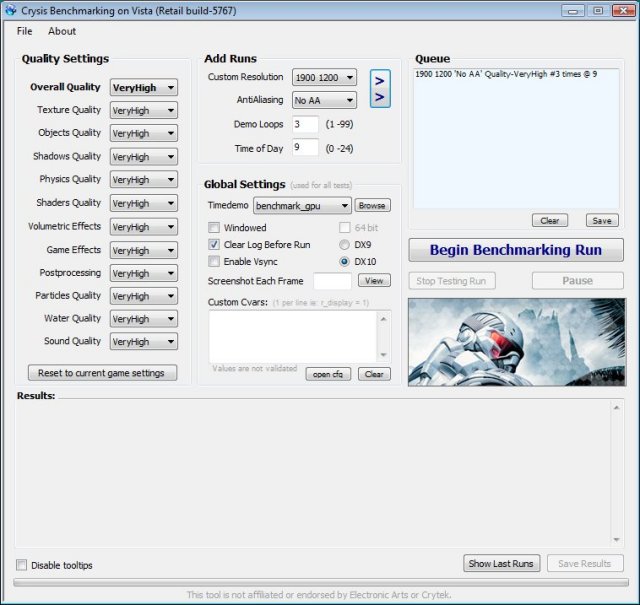
When we move into a game we see that the Visiontek 4890 holds its own against Crossfire 4850’s.
Even when the resolution is increased the 4890 is able to keep up to Crossfire 4850’s.
Surprisingly the Visiontek 4890 is still able to keep up to Crossfire 4850’s. A single 4890 is cheaper and quieter than running Crossfire with 4850’s. So far this card is looking great.
Far Cry 2
Far Cry 2, released in October 2008 by Ubisoft, was one of the most anticipated titles of the year. It’s an engaging state-of-the-art First Person Shooter set in an un-named African country. Caught between two rival factions, you’re sent to take out “The Jackal”. Far Cry2 ships with a full featured benchmark utility and it is one of the most well designed, well thought out game benchmarks we’ve ever seen. One big difference between this benchmark and others is that it leaves the game’s AI (Artificial Intelligence) running while the benchmark is being performed.
Right out of the gate the Visiontek 4890 does a good job getting ahead of the stock clocked 4890.
When the resolution is increased the Visiontek 4890 stays in roughly the same spot. As expected Crossfire 4890’s performs better than Crossfire 4870’s.
When we step up the resolution we see that the Visiontek 4890 is able to catch up to Crossfire 4850’s, and passes them by a tiny bit.
S.T.A.L.K.E.R. Clear Sky
S.T.A.L.K.E.R. Clear Sky is the latest game from the Ukrainian developer, GSC Game World. The game is a prologue to the award winning S.T.A.L.K.E.R. Shadow of Chernoble, and expands on the idea of a thinking man’s shooter. There are many ways you can accomplish your mission, but each requires a meticulous plan, and some thinking on your feet if that plan makes a turn for the worst. S.T.A.L.K.E.R. is a game that will challenge you with intelligent AI, and reward you for beating those challenges. Recently GSC Game World has made an automatic tester for the game, making it easier than ever to obtain an accurate benchmark of Clear Skie’s performance.

This is a bit of a disappointment for the Visiontek 4890. I was really expecting a lot more from this card. The card also scaled pretty bad. I usually have great scaling results in Stalker.
Again the Visiontek card had a hard time here in the Stalker test.
I guess the Visiontek card just didn’t like Stalker. Now that this ordeal is over lets move on to another test.
company of heroes
Company of Heroes(COH) is a Real Time Strategy(RTS) game for the PC, announced on April, 2005. It is developed by the Canadian based company Relic Entertainment and published by THQ. COH is an excellent game that is incredibly demanding on system resources thus making it an excellent benchmark. Like F.E.A.R., the game contains an integrated performance test that can be run to determine your system’s performance based on the graphical options you have chosen. Letting the games benchmark handle the chore takes the human factor out of the equation and ensures that each run of the test is exactly the same producing more reliable results.
The Crossfire 4890’s failed to pass the Crossfire 4870’s. The single 4890 on the other hand fared very well.
Again the single 4890 does a good job, but the 4890 Crossfire really lags behind.
This has been a really weird test for the 4890 Crossfire. It should have easily outperformed the Crossfire 4870’s.
World in Conflict
World in Conflict is a real-time tactical video game developed by the Swedish video game company Massive Entertainment, and published by Sierra Entertainment for Windows PC. The game was released in September of 2007. The game is set in 1989 during the social, political, and economic collapse of the Soviet Union. However, the title postulates an alternate history scenario where the Soviet Union pursued a course of war to remain in power. World in Conflict has superb graphics, is extremely GPU intensive, and has built-in benchmarks. Sounds like benchmark material to us!
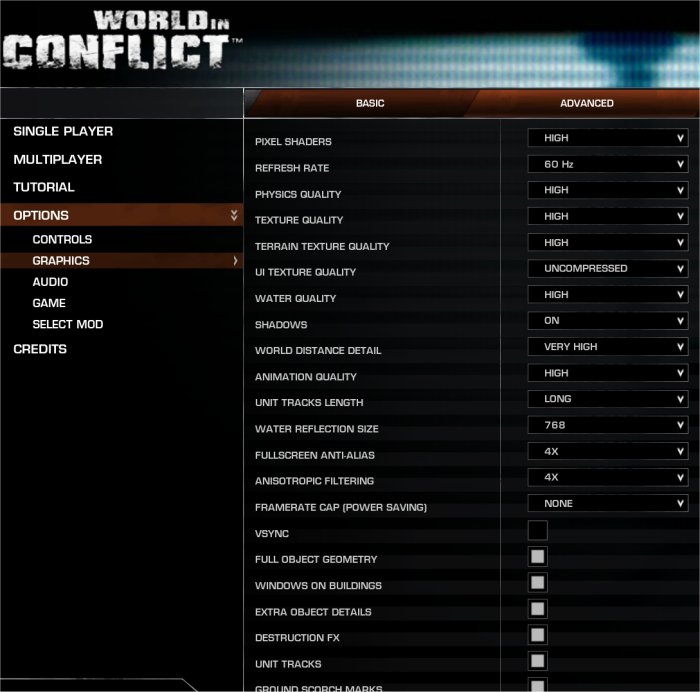
We see the exact opposite in this test. The Crossfire 4890 system really blasted past Crossfire 4870’s.
Again the Crossfire 4890’s are king. The single 4890 is still doing great against Crossfire 4850’s.
Again the 4890 rules. The single card almost matches Crossfire 4850’s, while Crossfire 4890’s completely stomp everything else.
temperatures
The VisionTek 4890 certainly was a cool card. I manually set the fan to 60%, which was the sweet spot between noise and performance. At 60% the fan was very hard to hear over my case fans. To test the load temperature I loaded up Furmark 1.7, and let it run for 30 minutes. I then recorded the maximum temperature reached. To test the idle temperature I let the card sit with no programs running. Below is a table of the results.
| Idle Temperature | Load Temperature |
|---|---|
| 43 |
74 |
This result is really great too see. The 4890 runs hot especially if its overclocked, and its always great to see a company make sure the cooling keeps up with the card.
conclusion
The Visiontek 4890 OC edition is a great edition to the Visiontek lineup. The card performed well against Crossfire’d 4850’s. With that kind of performance you should have no issue playing just about every game maxed out. You also have to look at the value of the 4890 versus Crossfire 4850’s. The 4890 is a fair amount cheaper than two 1 GB 4850’s. That is not the only advantage of the 4890. The 4890 also runs a lot cooler especially if your motherboard has the PCIE slots close together. With all the rage being power efficiency the 4890 is a very attractive option. The card has great power management. This combined with the excellent cooler on the card makes this one of the top 4890’s out there right now.
If you happen to be one of the people who want the most performance you can squeeze out of a computer you will be happy to see the raw numbers of 4890 Crossfire. With two of these cards working together you should have no issue playing even Crysis completely maxed out. You also should not have to break a sweat with the cooler on this card. You can be sure that the 4890 will be running much cooler than a 4890 with a stock cooler.
There are not a lot of flaws with this card, and the few that exist are not too bad. One is the card does not vent all of the hot air out of the case. If you run Crossfire with another card then your case will be scorching hot unless you have a lot of fans venting air out of the case. The other flaw with the card is the lack of a 8 pin PCIE connector. Visiontek should have taken a page out of Sapphires book and included this to help out overclocking. The card looses some ability to overclock, but since this card is already heavily overclocked this is not that bad.
We are using this scale with our scoring system to provide additional feedback beyond a flat score. Please note that the final score isn’t an aggregate average of the rating system.
- Performance 9
- Value 9
- Quality 9
- Warranty 7
- Features 8
- Innovation 8
Pros:
+ Great Performance
+ Aftermarket Cooler
+ Overclocked
Cons:
– Doesn’t Vent All Air Out Of The Case
– No 8 Pin PCIE Connector
The VisionTek HD4890 OC edition is a very powerful card that has no issue blazing through all of the latest games, and when combined with another card, is a force to be reconed with. This is why the card received a 8.5 out of 10, and the Bjorn3D Seal of Approval.
 Bjorn3D.com Bjorn3d.com – Satisfying Your Daily Tech Cravings Since 1996
Bjorn3D.com Bjorn3d.com – Satisfying Your Daily Tech Cravings Since 1996
